
Agnes of Rome is a virgin martyr, venerated as a saint in the Catholic Church, Oriental Orthodox Church and the Eastern Orthodox Church, as well as the Anglican Communion and Lutheran Churches. She is one of several virgin martyrs commemorated by name in the Canon of the Mass.
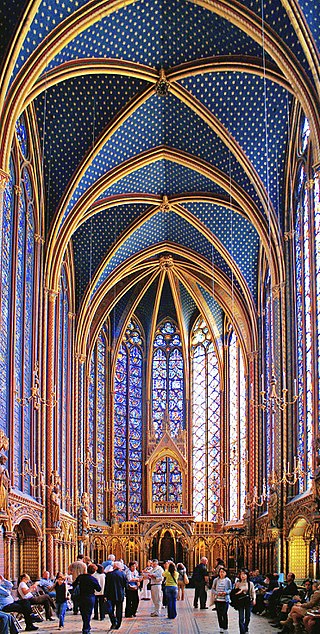
The Sainte-Chapelle is a royal chapel in the Gothic style, within the medieval Palais de la Cité, the residence of the Kings of France until the 14th century, on the Île de la Cité in the River Seine in Paris, France.

Amiens is a city and commune in northern France, located 120 km (75 mi) north of Paris and 100 km (62 mi) south-west of Lille. It is the capital of the Somme department in the region of Hauts-de-France and had a population of 135,429, as of 2021. A central landmark of the city is Amiens Cathedral, the largest Gothic cathedral in France. Amiens also has one of the largest university hospitals in France, with a capacity of 1,200 beds. The author Jules Verne lived in Amiens from 1871 until his death in 1905, and served on the city council for 15 years. Incumbent French president Emmanuel Macron was born in Amiens.

Île de la Cité is an island in the river Seine in the center of Paris. In the 4th century, it was the site of the fortress of the Roman governor. In 508, Clovis I, the first King of the Franks, established his palace on the island. In the 12th century, it became an important religious center, the home of Notre-Dame cathedral, and the royal chapel of Sainte-Chapelle, as well as the city's first hospital, the Hôtel-Dieu. It is also the site of the city's oldest surviving bridge, the Pont Neuf.

Fermin was a legendary holy man and martyr, traditionally venerated as the co-patron saint of Navarre, Spain. His death may be associated with either the Decian persecution (250) or Diocletianic Persecution (303).

The Cathedral Basilica of Our Lady of Amiens, or simply Amiens Cathedral, is a Roman Catholic church. The cathedral is the seat of the Bishop of Amiens. It is situated on a slight ridge overlooking the River Somme in Amiens, the administrative capital of the Picardy region of France, some 120 kilometres north of Paris.

Montdidier is a commune in the Somme department in the administrative region of Hauts-de-France, northern France.

Saint-Acheul is a commune in the Somme department in Hauts-de-France in northern France. It is not to be confused with Saint-Acheul, a suburb of Amiens after which the Acheulean archaeological culture of the Lower Paleolithic is named.

Aix Cathedral in Aix-en-Provence in southern France is a Roman Catholic church and the seat of the Archbishop of Aix-en-Provence and Arles. The cathedral is built on the site of the 1st-century Roman forum of Aix. Built and re-built from the 12th until the 19th century, it includes Romanesque, Gothic and Neo-Gothic elements, as well as Roman columns and parts of the baptistery from a 6th-century Christian church. It is a national monument of France.

Quimper Cathedral, formally the Cathedral of Saint Corentin, is a Roman Catholic cathedral and national monument of Brittany in France. It is located in the town of Quimper and is the seat of the Diocese of Quimper and Léon. Saint Corentin was its first bishop.
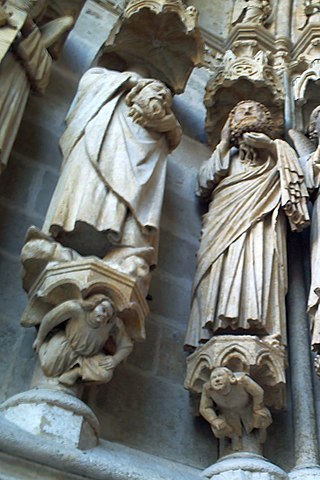
Victoricus, Fuscian and Gentian were three Christian martyrs later venerated as Roman Catholic saints. Their feast day falls on 11 December.

Saint Domitius (Domice) of Amiens is a French saint, venerated especially in the diocese of Amiens.

The Diocese of Amiens is a Latin Church diocese of the Catholic Church in France. The diocese comprises the department of Somme, of which the city of Amiens is the capital.

French Gothic architecture is an architectural style which emerged in France in 1140, and was dominant until the mid-16th century. The most notable examples are the great Gothic cathedrals of France, including Notre-Dame Cathedral, Reims Cathedral, Chartres Cathedral, and Amiens Cathedral. Its main characteristics are verticality, or height, and the innovative use of the rib vault and flying buttresses and other architectural innovations to distribute the weight of the stone structures to supports on the outside, allowing unprecedented height and volume. The new techniques also permitted the addition of larger windows, including enormous stained glass windows, which fill the cathedrals with light.

Tréguier Cathedral is a Roman Catholic church and former cathedral in Tréguier, Côtes-d'Armor, France. It is dedicated to Saint Tudwal. The church was formerly the seat of the Bishopric of Tréguier, abolished under the Concordat of 1801, when its territories were divided between the Diocese of Quimper and the Diocese of Saint-Brieuc, known since 1852 as Saint-Brieuc-Tréguier.
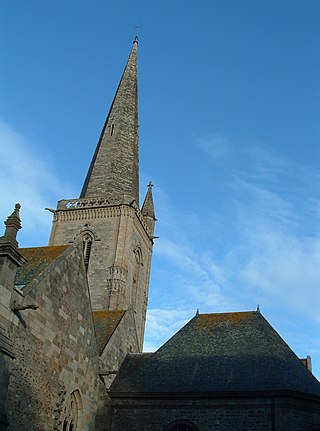
Saint-Malo Cathedral is a Roman Catholic Cathedral located in Saint-Malo, Brittany, France. The church was founded in dedication to Saint Vincent of Saragossa and is a national monument of France. It was built in a mix of Roman and Gothic styles during the episcopacy of Jean de Châtillon (1146-1163) on the site of an ancient church founded in the 7th century. The cathedral suffered damage during World War II when the steeple toppled onto the Sacred Heart Chapel. An organ which had been built in 1893 by Louis Debierre was destroyed. On 21 May 1972, after 28 years of work, a ceremony was held to celebrate the completion of the restoration. It is a stop on the Tro Breizh, a Catholic pilgrimage that links the towns of the seven founding saints of Brittany.

Saint Paul Aurelian Cathedral was a Roman Catholic cathedral, now basilica, in Saint-Pol-de-Léon, in the Finistère department in Brittany in north-western France. The 13th-century church stands on the site of the original church founded by Saint Paul Aurélien in the 6th century. It is a listed monument since 1840.
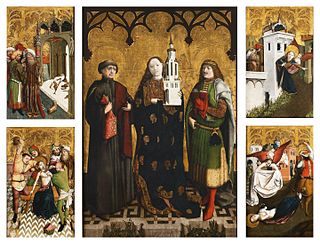
Saint Barbara, known in the Eastern Orthodox Church as the Great Martyr Barbara, was an early Christian Greek saint and martyr.
Amiens is a city and commune in northern France, 120 km (75 mi) north of Paris and 100 km (62 mi) south-west of Lille. It is the capital of the Somme department in Nord-Pas-de-Calais-Picardie. The city had a population of 136,105 according to the 2006 census.
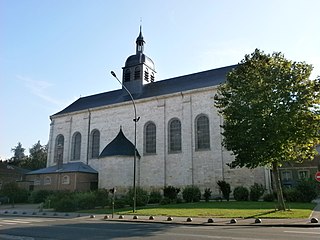
The Abbey of Saint-Acheul was a monastery of Canons Regular in the Saint-Acheul district of Amiens, France. It was founded in the 11th century on the site of an ancient church, and was suppressed in 1790 during the French Revolution. The buildings, which date to the 18th century, were taken over by a college that was entrusted to the Jesuits in 1814. They are now occupied by the private Lycée Saint-Riquier. The abbey church is used as a parish church.






















